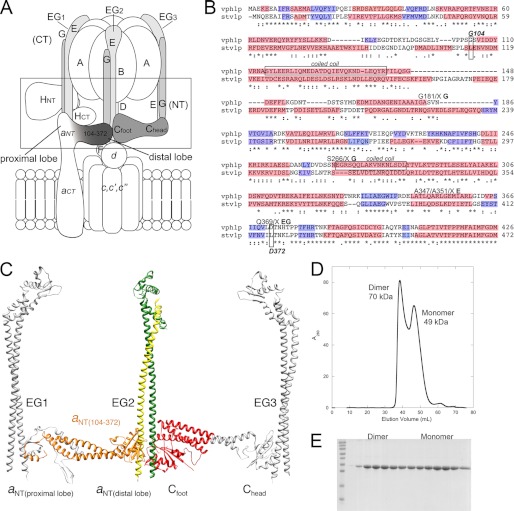FIGURE 1.
Design of vph1 N-terminal domain construct. A, schematic representation of the V-ATPase with the subunits at the V1-Vo interface outlined by the box. The region of subunit a involved in the construct used in this study is shaded. Peripheral EG stators are numbered as in Ref. 6. B, sequence alignment shaded according to the secondary structure prediction for the N-terminal domains of the two yeast subunit a isoforms, Vph1p and Stv1p. The primary sequence is shaded in pink and blue, representing α helices and β sheet, respectively. The sites of cross-linking to the EG heterodimer are marked on the alignment. The N- and C-terminal boundaries for aNT(104–372) were chosen to preserve conserved structural elements as well as potential sites of interaction with other subunits. C, structural model of the peripheral stalk domain of yeast V-ATPase. Shown are structures of the EG heterodimer (from Thermus thermophilus, 3k5b), subunit C from yeast V-ATPase (1u7l), and a structural model of yeast aNT (the primary sequence of the Vph1p N-terminal domain threaded into the crystal structure of the archaeal ATPase INT domain, 3rrk. See supplemental Fig. S1 for details). As can be seen, construct aNT(104–372) constitutes the distal lobe and flanking coiled-coil segments (highlighted in orange in the aNT structural model), thus preserving the binding sites to both EG2 and Cfoot (colored in green, yellow, and red, respectively). D, size exclusion chromatography of construct aNT(104–372). The protein elutes as two species corresponding to monomer and dimer. The predicted molecular mass of the monomer is 31.5 kDa. The observed molecular masses are marked on the chromatograph. The larger observed molecular masses for the construct likely indicate that the molecule is elongated in solution. E, SDS-PAGE gel of purified aNT(104–372) from the size exclusion chromatography run in D. The two peaks can be seen on the gel, and the purity of both species indicates that no contaminants are contributing to the two species observed.

